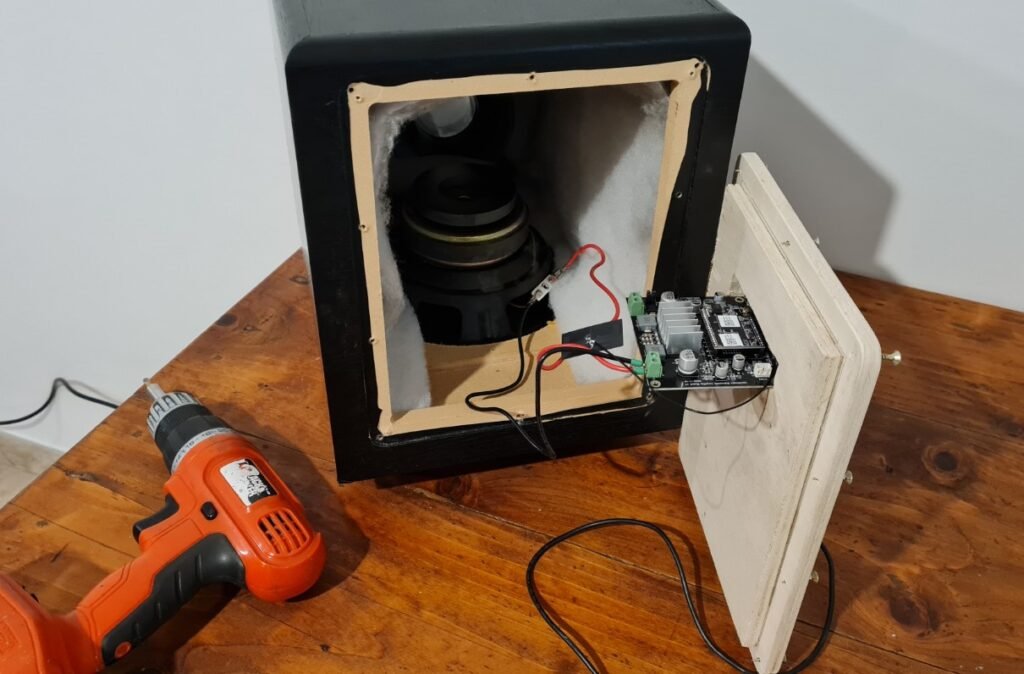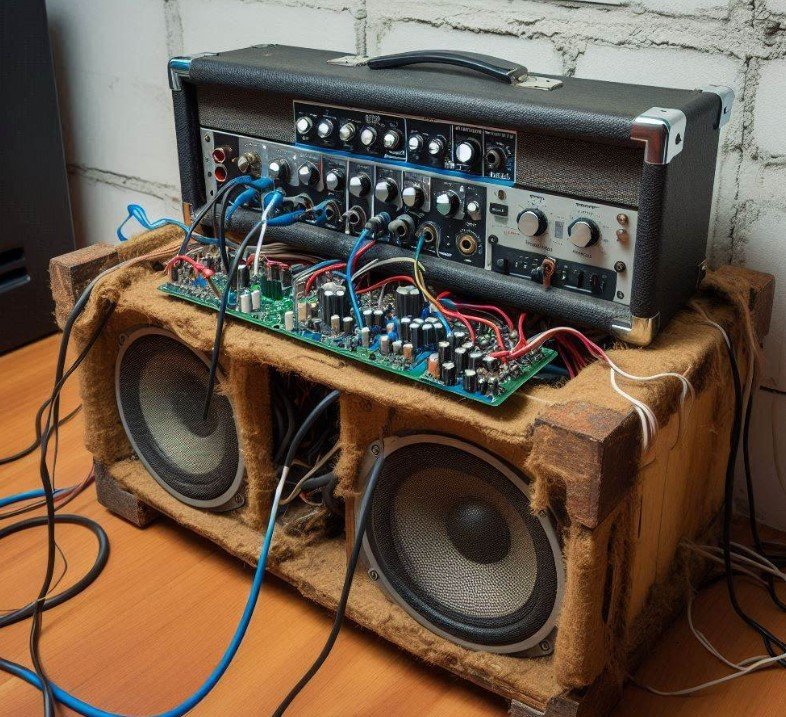In this article, I’ll explain How To Convert A Powered Sub To Passive Subwoofer? Have you attempted to understand the mechanics behind transforming a powered subwoofer into a passive one? It is not that difficult to convert an active sub to a passive! It is just a matter of a few minutes to do the switch and enhance the sound system with a new subwoofer. Let us analyze the steps!
How To Convert A Powered Sub To Passive Subwoofer?
To achieve a passive subwoofer-powered conversion, the internal amplifier must be removed. Connect the external amplifier to the sub after turning off the power supply and opening the case to remove it. Even though powered subwoofers come in one complete and compact unit, it is possible to make one a passive subwoofer by simply unscrewing the amplifier from the case. After this modification is complete, the sub will require the use of external power for driving it.

Is Converting An Active Subwoofer To Passive Subwoofer Ok?
Yes, converting an active subwoofer into a passive one is achievable but may not necessarily be the best option. Active subs have built-in friction amps, specially designed for their drivers. Hence, if the amp is taken out, it may compromise the sound quality. Furthermore, you will have to install an external amplifier for the passive sub to work, on top of the other accessories. This may pile up extra costs and enhance complications on your setup. It is advisable to think about whether this is necessary or not given your acoustic requirements.
Can I Convert An Active Subwoofer To Passive?
Certainly, one can transform a powered subwoofer into a passive one by removing the built-in amplifier that comes with it. After this is completed, a separate external amplifier will be necessary to drive the sub. The procedure is rather complex and may impact the sound quality. If there is no external amplifier of equal amount of power to the power rating of the subwoofer used, the subwoofer may suffer damage in the other case. Or rather, the subwoofer may get damaged. Assess the benefits and the expenses, before resolving to make such a conversion.

Converting Active/Powered Sub To Passive/External Amplified
You have to follow these steps to convert an active sub to a passive;
- Informally speaking, it is possible to transform an active subwoofer into a passive one by dismantling the internal amplifier.
- Subwoofers need to be powered by an external amplifier after the conversion.
- This includes eliminating the sub’s power source and tedious internal amplifier.
- It is equally important that the output power of the external amplifier be between the minimum and maximum power rating of the subwoofer for proper operation.
- The tone may change and the conversion may be difficult so think about the advantages before doing this.
Is Passive Or Powered Subwoofer Better?
The passive subwoofer is better as compared to the powered subwoofer. A powered subwoofer with an amplifier means that the configuration is not so hassle-ridden, and thus, for those individuals who do not want to be bothered by the bother of running external amps, this is just the perfect fit for just plug-and-play. Powered subs assure the best low-end control and power too.

A passive sub is that which has its input still on the amp or outside. This provides many more options as well as scope for modification since one can add, alter, or remove the external amp. This will eventually attract more equipment. This choice is then left to your whole sound setup and what you require.
What Do I Need For A Passive Subwoofer?
An outside amplifier will be required in an active subwoofer. It forms the amping device that gets your subwoofer working and boosted up with the bass frequencies. Proper wiring will be for an active one to attach your amp to an audio system. Ideally, the amp has to have a power requirement that is the same as that of the subwoofer. Any mismatched power will make your sub distorted and in extreme cases, get broken. Other connections that can prove to be on the same par of importance include speaker wires as well as RCA cables.
How To Convert Passive Subwoofers Into Active?
Adding a second, separate power amplifier to an otherwise passive subwoofer can convert that passive subwoofer into an active one. Here is how you may easily make passive subwoofers into active ones:
Making The Right Amplifier Choice
Wait, what do you mean by an amplifier rated equal to that of the subwoofer impedance ohm and power output watts, expanding on that? Also, think about which type of amplifier would work better within your system: a mono or soundproof multi-channel amplifier. Therefore, the positive axial connector of the amplifier should be interlinked to the plus terminal while, at the same time the negative axial connector of the amplifier should connect to the negative terminal of the subwoofer.
Connect Power to Amplifier
Connect the amplifier to a power source, connect it to an AC outlet for the home setup, or to 12V power for the car setup. Add a fuse for safety, just to prevent power surges from frying the amp.
Low-Pass Filter
If there’s no low-pass filter installed in your amp, then install one to restrict only low frequencies going to your subwoofer.
Amplifier Settings
- Have your gain control adjusted so that distortion is prevented.
- Set the crossover frequency for the best bass at between 80 and 100 Hz.
- Adjust the **phase** knob if necessary to align with other speakers.
Testing and Fine-tuning
- Test the subwoofer with some audio that contains deep bass.
- Tuning for the best sound possible, gain, crossover, phase settings, and crossover selected.
- Air flow should be allowed to the amplifier properly.
- A good subwoofer enclosure and good cables will make this unit shine well.
This process allows the passive subwoofer to be turned into an active one with amplified control, power, and therefore better bass.
Can I Use a Broken Amp As A Passive Sub?
You probably can do that but it can cause you to bypass or you have to remove the broken amp parts and then hardwire it directly into a new external amp. That is such an elaborate procedure. This will not give the best result, too. So, if I were you, I would rather get it repaired or changed instead of doing the conversion like this.

Can You Convert Dead Subwoofer To Passive Subwoofer?
Yes, you can convert a dead subwoofer to a passive subwoofer. This is just a sample of how it might be a passive subwoofer. But in a situation where the subwoofer does not function, then only if the speaker was not faulty as well would it be taken for granted to be a passive subwoofer.
What needs to come out in this situation is the faulty amp stuck inside. Then connect the subwoofer with an external amp for the output of sound. And, fingers crossed, it should power the active subwoofer back on, pending things going right. But it probably won’t sound like it might be able to if the sub were built to its intended design when it’s finished.
Can I Rewire An Active Sub To Be Passive?
Yes, you can rewire the active sub to be passive, So, you need to bypass the internal amplifier, and then you’ve got a live sub. Sub with an amplifier which is passive indeed. Then you go to some kind of external amplifier, take your power from that, and make the wires and connection such that you wouldn’t damage your sub or anything. Well, that does call for know-how of circuitry on the side of the subwoofer. Don’t know? Well, bring in a professional to do it.
Can You Connect A Passive Subwoofer To A Receiver?
Not to say that in a lot of cases, one cannot connect a passive subwoofer directly to the receiver; on the other hand, due to low power output levels, active subwoofers cannot be connected directly to the receivers. It is, nevertheless, a well-established custom to connect the power amplifier to the subwoofer first and then connect the power amplifier to the receiver second. This naturally means you’ll want to make sure your receiver has an output jack for a subwoofer, so you can drive high-quality signals all the way

Can You Run A Powered Sub Off An Amp?
A powered subwoofer has the amplifier built-in, so you do not hook directly to the power of an amplifier; you can still have it connected to a preamp or an audio receiver via the control of the signal. Unless you’re using the receiver or amp, which has a subwoofer output then you connect a sub to another amp without killing the gear.
Can You Use An Active Subwoofer With On A Passive Subwoofer Output?
Technically Yes. Since the powered sub owns an amplifier, if you pass through from a line output, it would use no power at all. Just plug the sub’s input into the receiver’s subwoofer output. Keep an eye on your levels, too, just in case nothing is holding or bending them. Active subs only take audio, of course, and as they don’t require power for this.

How To Connect A Powered Subwoofer To Passive Speakers?
It should be connected to the powered subwoofer at the passive speakers by taking the direct subwoofer output to the terminals of the speakers so that the subwoofer will take care of the low frequencies and the passive speakers will take care of the mid and high frequencies. This configuration will require crossover to realize good sounds. Sublevels by the level of the passive speakers so that audio will be well balanced.
How Can I Connect A Passive Subwoofer To A Non-Subwoofer Connection?
Attaching a passive subwoofer is not very difficult using an unfavored connection that is not a subwoofer hook-up. This is done by using an external amplifier or amp to power the subwoofer and driving the low-pitched frequencies.
Well then, obviously if your audio source does not have a subwoofer output you can use a crossover. That of course, means that one of the options you do have is a crossover which can be so unflattering by cutting off some of the higher frequencies, and at the same time, your low frequencies connect only to your subwoofer.
Conclusion
To conclude, this post provided detailed steps and an entirely correct application for changing a powered subwoofer into a passive one. This only refers to removing the internal amplifier and later re-routing any connections attached. Honestly, it would allow one to connect their subwoofer to an external amplifier. Yeah, but a plan that degrades the quality of sound. What you want is you be guided under the right so you won’t damage the equipment. Otherwise, you can also take it to a pro in case you are not so sure of it.
Top FAQ’s
Can you convert a powered sub to passive?
Well, you can just disengage the integrated amp and use an outer one.
What kind of equipment options do you have to replace?
You will need an outer amplifier and quality speaker cables for connection.
Is replacing a powered subwoofer with a passive subwoofer safe or not?
Yes, but on proper procedure without damaging it.
Will this change, in any way, impact the sound quality at all once it’s changed?
It depends on the external device you want to pair with the amp.
